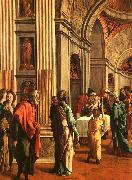
Oil On
Canvas, Real Flavor of Old Masters
|
Broederlam, Melchoir
|
|||
|
|
|||
| Flemish, active 1381-1409 | |||
|
|
|||
|
|
The Presentation in the Temple new3/Broederlam, Melchoir_zNRs3g.jpg Painting ID:: 18876 Visit European Gallery |
1393-99, Mus??e des Beaux-Arts at Dijon | |
Height Width |
INS/CM |
||
|
X |
|
||
|
|
|||
|
Jan van Scorel
|
|||
|
|
|||
| Dutch 1495-1562 Jan Van Scorel Galleries Jan van Scorel (1495, Schoorl - December 6, 1562, Utrecht) was an influential Dutch painter credited with the introduction of High Italian Renaissance art to the Netherlands. It is not known whether he began his studies under Jan Gossaert in Utrecht or with Jacob Cornelisz in Amsterdam, but it certain that it was the master painters he would meet later in his life who would have the greatest effect on his technique. Van Scorel began traveling through Europe in his early twenties, first heading to Nuremberg and then to Austria. It was there, in 1520, that he completed his first representative work, the "Sippenaltar" in St. Martin's church in the village of Obervellach. Giorgione served as a considerable influence on van Scorel during a tenure in Venice. Upon leaving Venice, van Scorel passed through Rome and made a pilgrimage to the Holy Land. His experiences in Jerusalem are depicted in many of his later works. In 1521, van Scorel returned to Rome where he met Pope Adrian VI, who appointed him painter to the Vatican. He himself sat for a portrait. Van Scorel enjoyed the influence of Michelangelo and Raphael, and succeeded Raphael as Keeper of the Belvedere. Upon his return to the Netherlands in 1524, he settled in Haarlem where he began a successful career as a painter and a teacher. Van Scorel was a very educated man and skilled as an engineer and an architect, as well as an artist. He was also multi-lingual, no doubt as a result of his travels. Considered to be the leading Netherlandish Romanist, van Scorel moved to Ghent for painting contracts before moving to Utrecht for the same reason, where he died in 1562, leaving behind a wealth of portraits and altarpieces. Though many of his works fell victim to the Iconoclasm in 1566, some still remain and can be seen primarily at museums in the Netherlands. | |||
|
|
|||
|
|
The Presentation in the Temple Jan van Scorel1.jpg Painting ID:: 3865 Visit European Gallery |
Art History Museum, Vienna | |
Height Width |
INS/CM |
||
|
X |
|
||
|
|
|||
|
Ambrogio Lorenzetti
|
|||
|
|
|||
| Italian Byzantine Style Painter, ca.1290-1348 Ambrogio Lorenzetti (or Ambruogio Laurati; c. 1290 ?C June 9, 1348) was an Italian painter of the Sienese school. He was active between approximately from 1317 to 1348. His elder brother was the painter Pietro Lorenzetti. His work shows the influence of Simone Martini, although more naturalistic. The earliest dated work of the Sienese painter is a Madonna and Child (1319, Museo Diocesano, San Casciano). His presence was documented in Florentine up until 1321. He would return there after spending a number of years in Siena. The frescoes on the walls of the Hall of the Nine (Sala dei Nove) or Hall of the Peace (Sala della Pace) in the Palazzo Pubblico of Siena are one of the masterworks of early renaissance secular painting. The "nine" was the oligarchal assembly of guild and monetary interests that governed the republic. Three walls are painted with frescoes consisting of a large assembly of allegorical figures of virtues in the Allegory of Good Government . In the other two facing panels, Ambrogio weaves panoramic visions of Effects of Good Government on Town and Country, and Allegory of Bad Government and its Effects on Town and Country (also called "Ill-governed Town and Country"). The better preserved "well-governed town and country" is an unrivaled pictorial encyclopedia of incidents in a peaceful medieval "borgo" and countryside. The first evidence of the existence of the hourglass can be found in one of his paintings. Like his brother, he is believed to have died of bubonic plague 1348. Giorgio Vasari includes a biography of Lorenzetti in his Lives. | |||
|
|
|||
|
|
The Presentation in the Temple new3/Ambrogio Lorenzetti-386782.jpg Painting ID:: 29040 Visit European Gallery |
mk65 Tempera on panel 101 3/16x33 3/16in Uffizi, | |
Height Width |
INS/CM |
||
|
X |
|
||
|
|
|||
|
Stefan Lochner
|
|||
|
|
|||
| German painter (b. ca. 1400, Meersburg am Bodensee, d. 1451, Köln was a German late Gothic painter. His style, famous for its clean appearance, combined Gothic attention towards long flowing lines with brilliant colours with a Flemish influenced realism and attention to detail. He worked mainly in Cologne, Germany, and his principal work is the triptych of the Altar of the City Patrons (done in the 1440s, which is in the Cologne Cathedral), which represents the city in homage to the infant Jesus. The epitome of his style is Madonna of the Rose Bower (c. 1450, housed in the Wallraf-Richartz Museum in Cologne), showing the Virgin and Child reposing in a blooming rose arbor and attended by Lochner's characteristic child Angels. | |||
|
|
|||
|
|
The Presentation in the Temple new9/Stefan Lochner-748433.jpg Painting ID:: 33359 Visit European Gallery |
mk86 1447 139x126cm Darmstadt,Hessisches Landesmuseum | |
Height Width |
INS/CM |
||
|
X |
|
||
|
|
|||










